Advanced Hybrid Beamforming Technique in MU-MIMO Systems
Abstract
:1. Introduction
2. System Model
2.1. Fully Connected Structure
2.2. Partially Connected Structure
2.3. 3-Dimension Spatial Channel Model
3. Conventional Hybrid Beamforming System
4. Advanced Hybrid Beamforming System
5. Simulation Results
5.1. Bit Error Rate According to SNR
5.2. Average Sum Rate According to SNR
5.3. Average Sum Rate According to the Number of Transmit Antennas
5.4. Computing Complexity According to the Number of Bits
6. Conclusions
Author Contributions
Funding
Conflicts of Interest
References
- Ji, M.; Wang, Z.; Liu, Q.; Zhou, L. A hardware-efficient hybrid beamforming solution for mmWave MIMO systems. IEEE Wirel. Commun. 2019, 26, 137–143. [Google Scholar]
- Haro, C.A.; Mestre, X. Learning and data-driven beam selection for mmWave communications: An angle of arrival-based approach. IEEE Access 2019, 7, 20404–20415. [Google Scholar] [CrossRef]
- Zhang, J.; Zheng, Z.; Zhang, Y.; Xi, J.; Gui, G. 3D MIMO for 5G NR: Several observations from 32 to massive 256 antennas based on channel measurement. IEEE Commun. Mag. 2018, 56, 62–70. [Google Scholar] [CrossRef]
- Huang, Y.; Li, Y.; Ren, H.; Lu, J.; Zhang, W. Multi-panel MIMO in 5G. IEEE Commun. Mag. 2018, 56, 56–61. [Google Scholar] [CrossRef]
- Ro, J.H.; Lee, W.S.; Ha, J.K.; Song, H.K. An Efficient precoding method for improved downlink massive MIMO system. IEEE Access 2019, 7, 112318–112326. [Google Scholar] [CrossRef]
- Choi, S.J.; Shim, S.J.; You, Y.H.; Cha, J.S.; Song, H.K. Novel MIMO detection with improved complexity for near-ML detection in MIMO-OFDM systems. IEEE Access 2019, 7, 60389–60398. [Google Scholar] [CrossRef]
- Sohrabi, F.; Yu, W. Hybrid analog and digital beamforming for mmWave OFDM lcarge-scale antenna arrays. IEEE J. Sel. Area Commun. 2017, 35, 1432–1443. [Google Scholar] [CrossRef] [Green Version]
- Sohrabi, F.; Yu, W. Hybrid digital and analog beamforming design for large-scale antenna arrays. IEEE J. Sel. Top. Signal Process. 2016, 10, 501–513. [Google Scholar] [CrossRef] [Green Version]
- Jiang, L.; Jafarkhani, H. Multi-user analog beamforming in millimeter wave MIMO systems based on path angle information. IEEE Trans. Wirel. Commun. 2019, 18, 608–619. [Google Scholar] [CrossRef]
- Kwon, K.H.; Hwang, D.D.; Song, H.K.; Nam, S.S. Full-duplex with self-energy recycling in the RF powered multi-antenna relay channels. IEEE Signal Process. Lett. 2019, 26, 1516–1520. [Google Scholar] [CrossRef]
- Chen, Y.; Chen, D.; Jiang, T. Non-uniform quantization codebook-based hybrid precoding to reduce feedback overhead in millimeter wave MIMO systems. IEEE Trans. Commun. 2019, 67, 2779–2791. [Google Scholar] [CrossRef] [Green Version]
- He, S.; Wang, J.; Huang, Y.; Ottersten, B.; Hong, W. Codebook-based hybrid precoding for millimeter wave multiuser systems. IEEE Trans. Signal Process. 2017, 65, 5289–5304. [Google Scholar] [CrossRef]
- Bjornson, E.; Van der Perre, L.; Buzzi, S.; Larsson, E.G. Massive MIMO in sub-6 GHz and mmWave: Physical, practical, and use-case differences. IEEE Wirel. Commun. 2019, 26, 100–108. [Google Scholar] [CrossRef] [Green Version]
- Ademaj, F.; Taranetz, M.; Rupp, M. 3GPP 3D MIMO channel model: A holistic implementation guideline for open source simulation tools. Eurasip J. Wirel. Commun. Netw. 2016, 55, 1–14. [Google Scholar] [CrossRef] [Green Version]
- Kim, W.C.; Paek, M.J.; Song, H.K. Relay selection scheme for multi-hop transmission of MU-MIMO system. Appl. Sci. 2018, 8, 1747. [Google Scholar] [CrossRef] [Green Version]
- Reil, M.; Lloyd, G. Millimeter-Wave Beamforming: Antenna Array Design Choices and Characterization; Rohde and Schwarz: Munich, Germany, 2016; pp. 1–26. [Google Scholar]
- Hu, Y.; Hong, W. A novel hybrid analog-digital multibeam antenna array for massive MIMO applications. In Proceedings of the 2018 IEEE Asia-Pacific Conference on Antennas and Propagation, Auckland, New Zealand, 5–8 August 2018. [Google Scholar]
- Zhang, J.A.; Huang, X.; Dyadyuk, V.; Guo, Y.J. Massive hybrid antenna array for millimeter-wave cellular communications. IEEE Wirel. Commun. 2015, 22, 79–87. [Google Scholar] [CrossRef]
- Kim, C.H.; Son, J.S.; Kim, T.Y.; Seol, J.Y. On the hybrid beamforming with shared array antenna for mmWave MIMO-OFDM systems. In Proceedings of the 2014 IEEE Wireless Communications and Networking Conference, Istanbul, Turkey, 6–9 April 2014. [Google Scholar]
- Li, Y.; Zhang, Y.; Han, Z.; Tang, S.; Jing, L.; Chiu, C.Y.; Murch, R. Analog precoding using highly reconfigurable antennas. IEEE Wirel. Commun. Lett. 2020, 9, 648–652. [Google Scholar] [CrossRef]
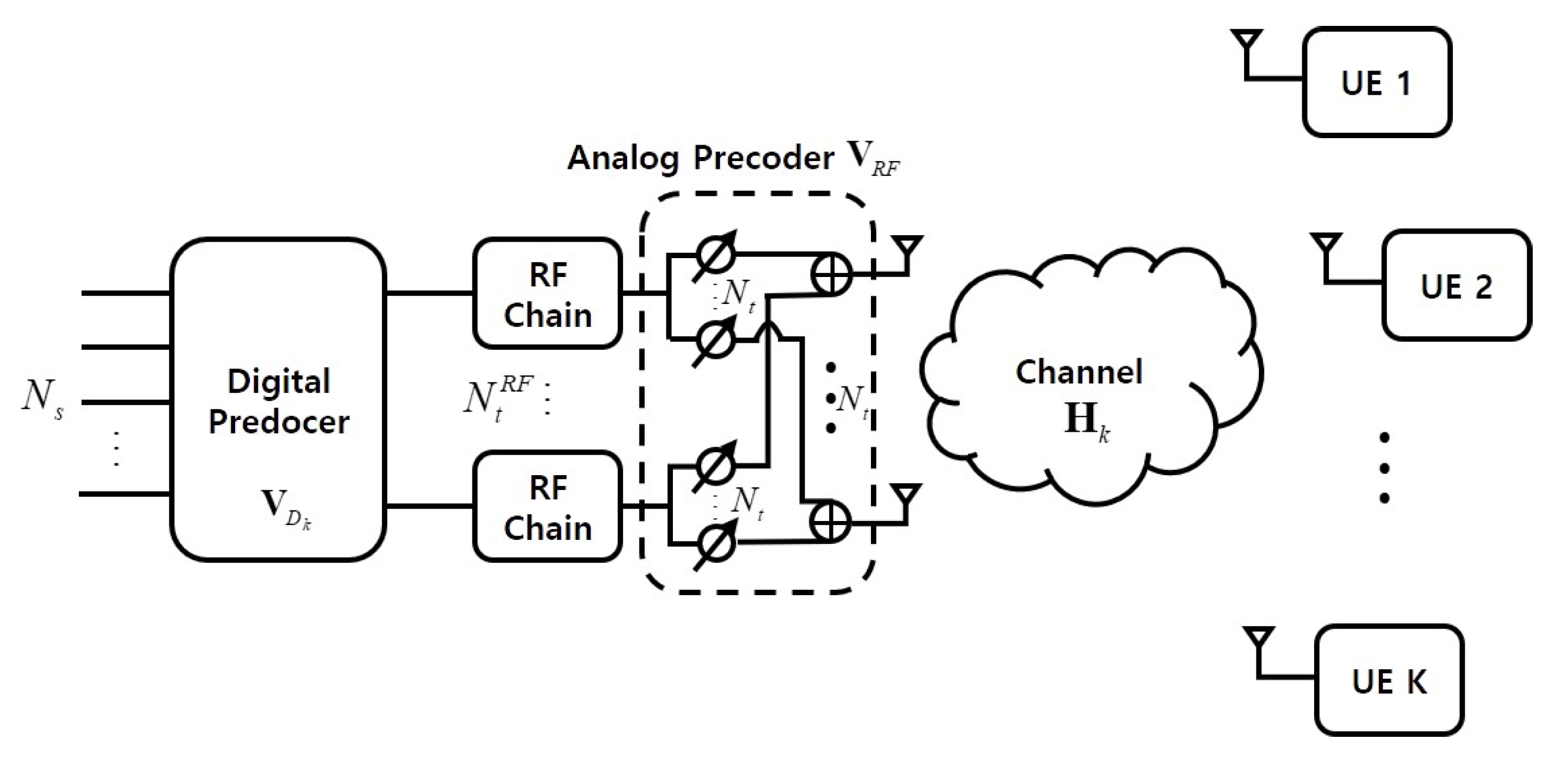
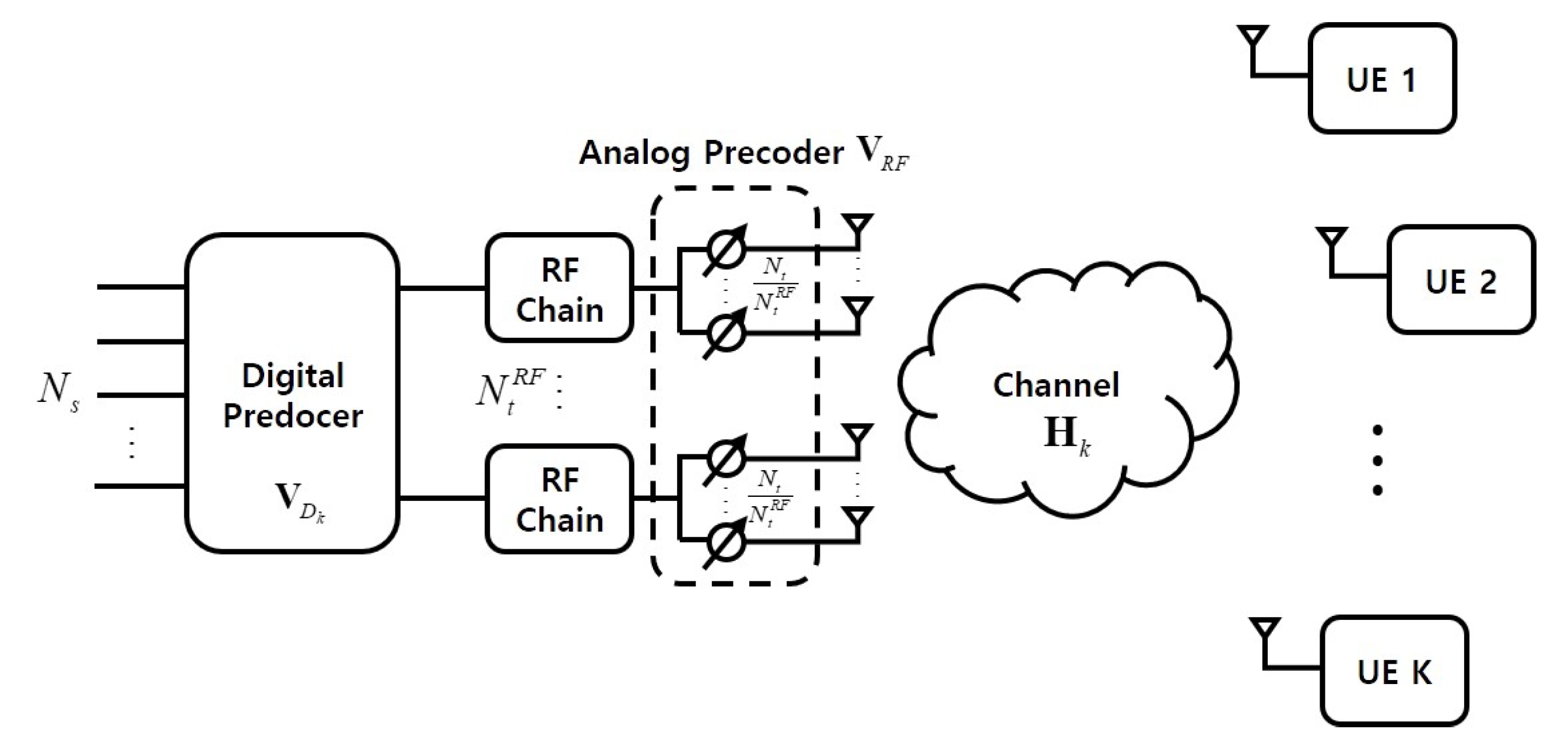



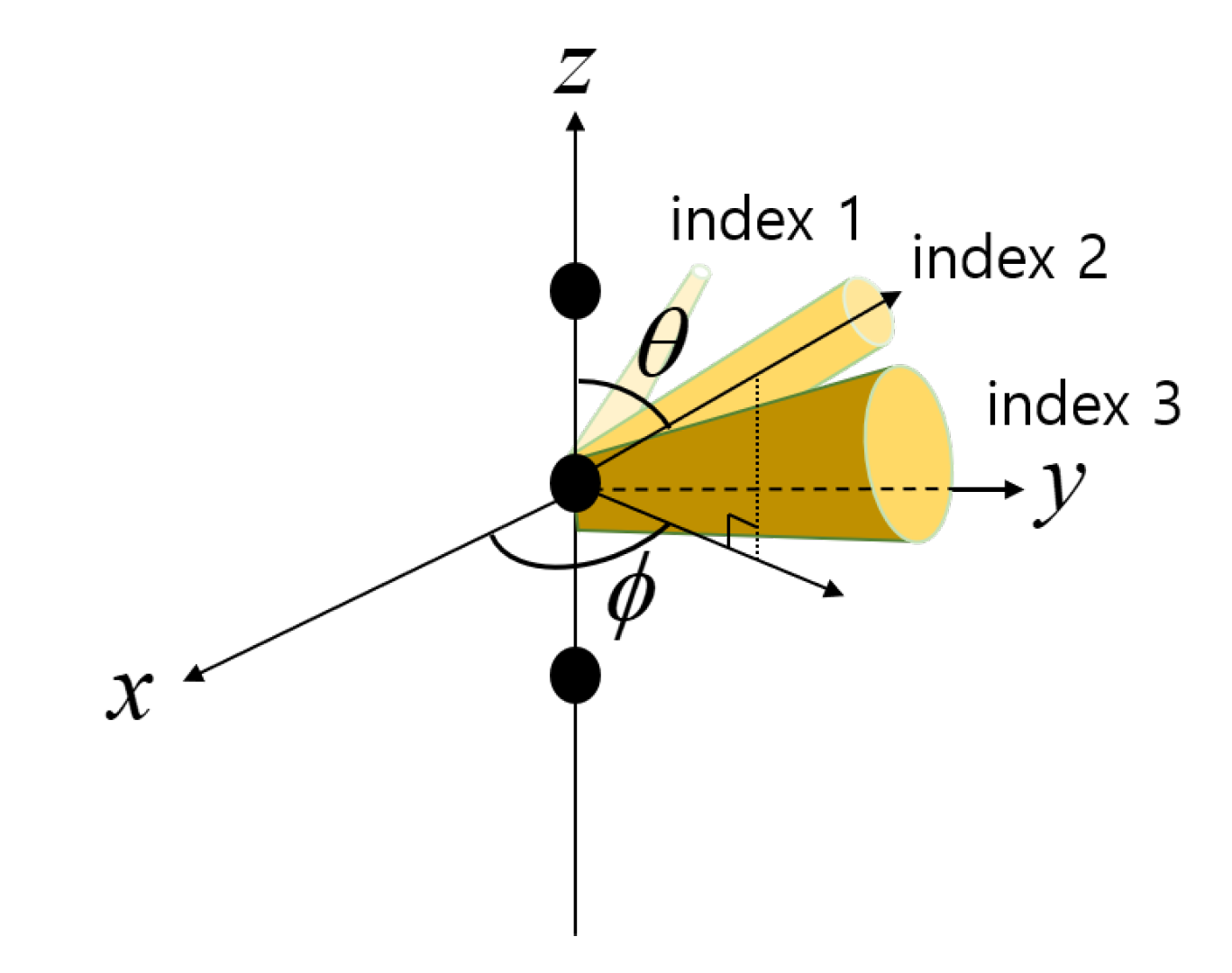
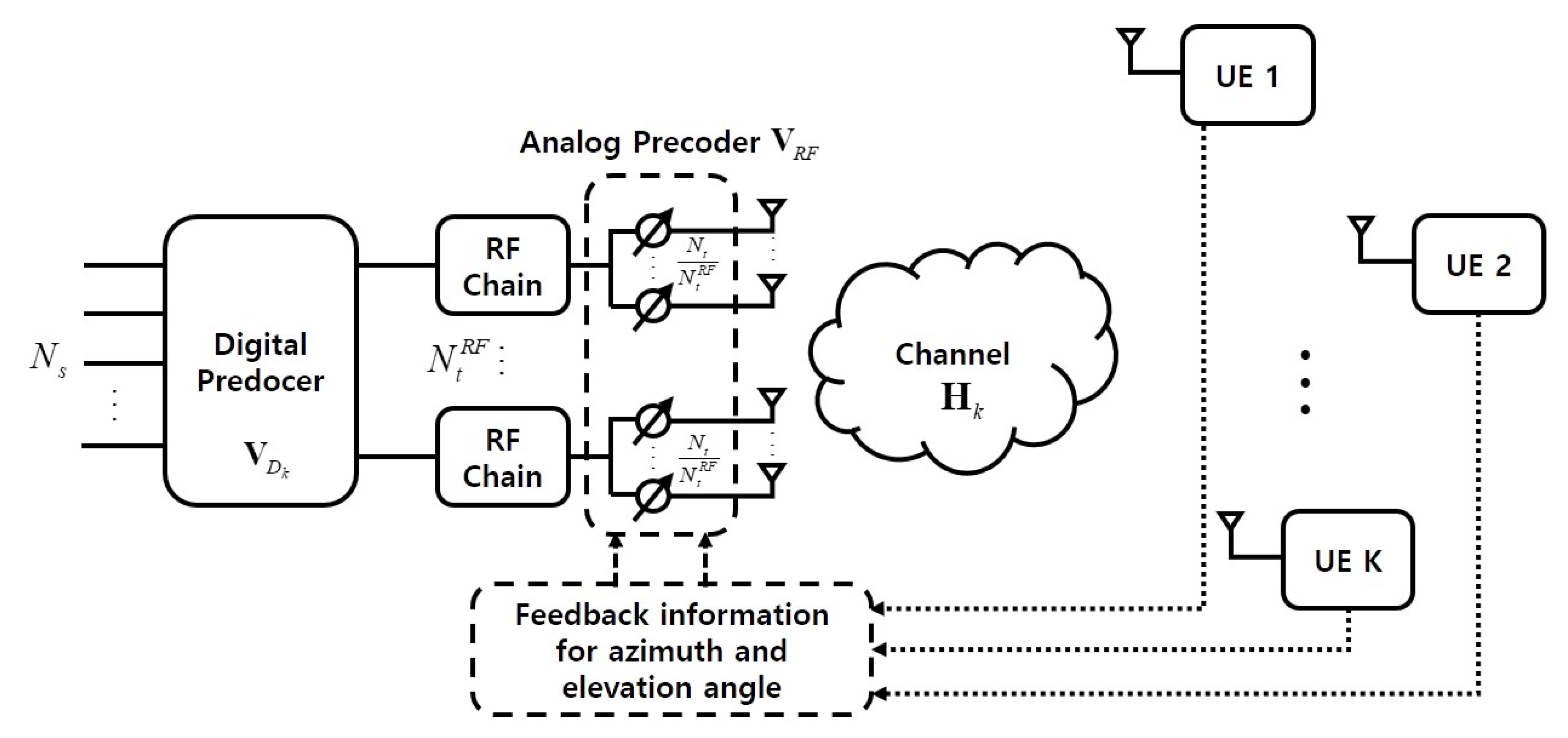
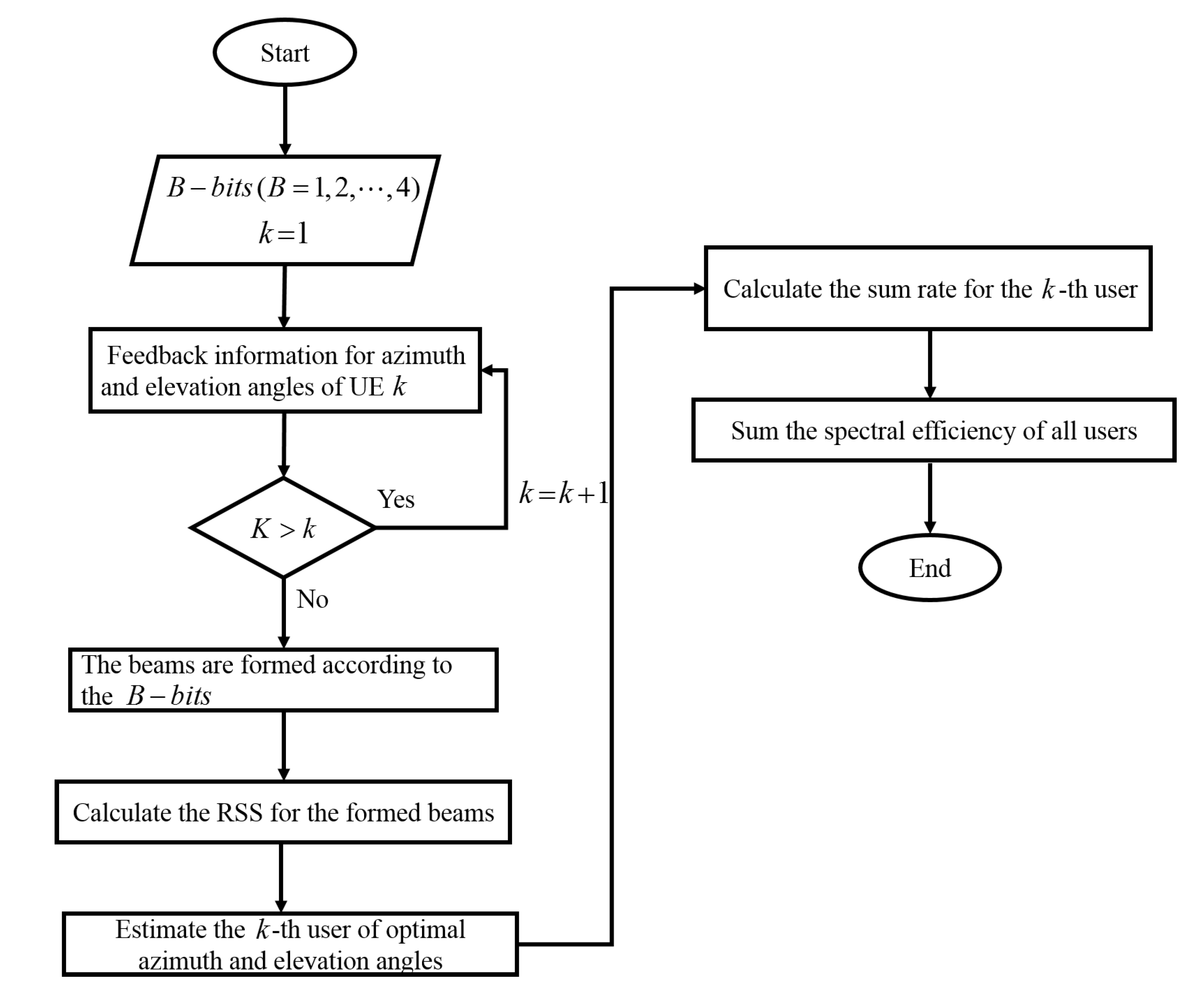
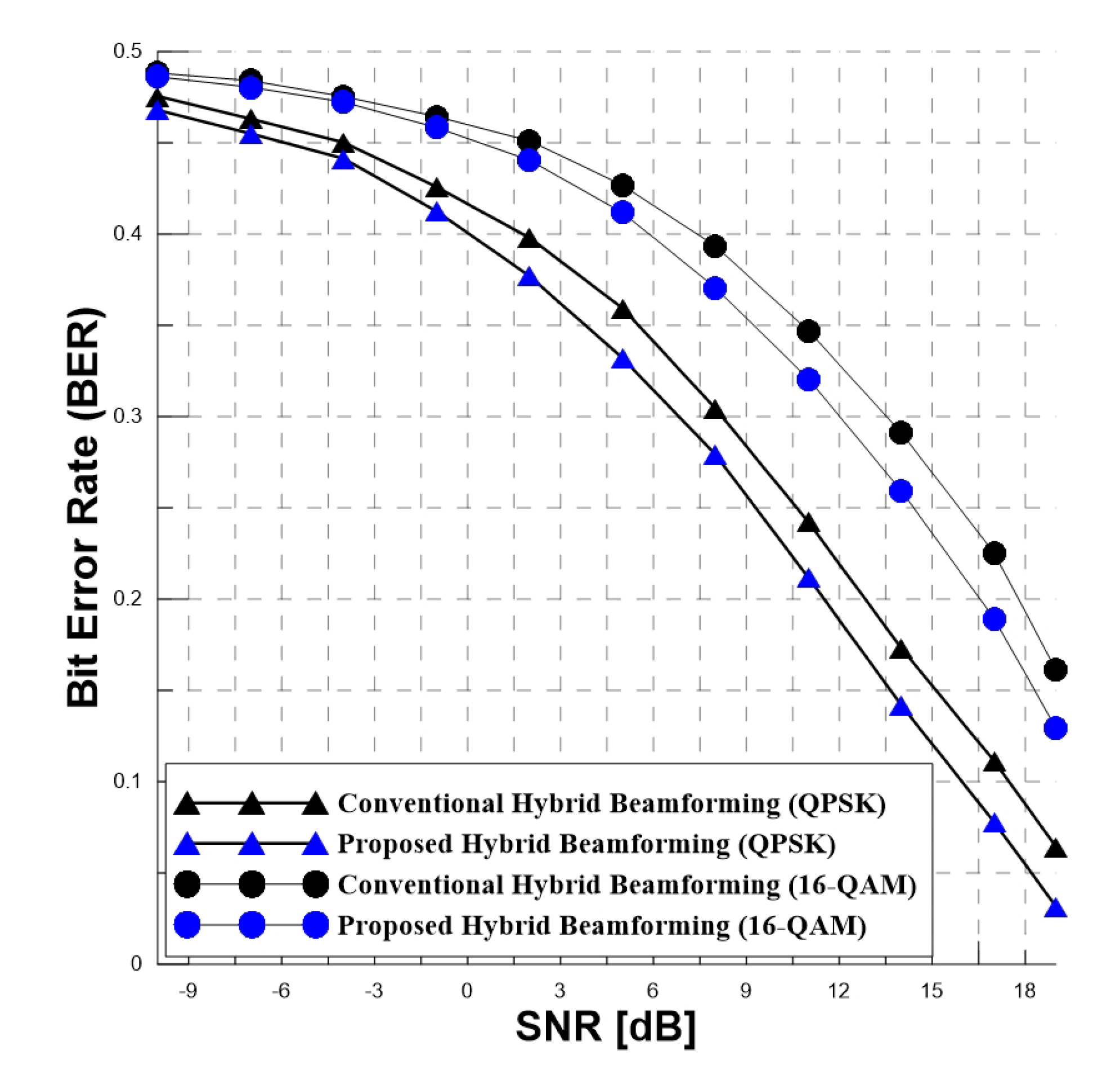


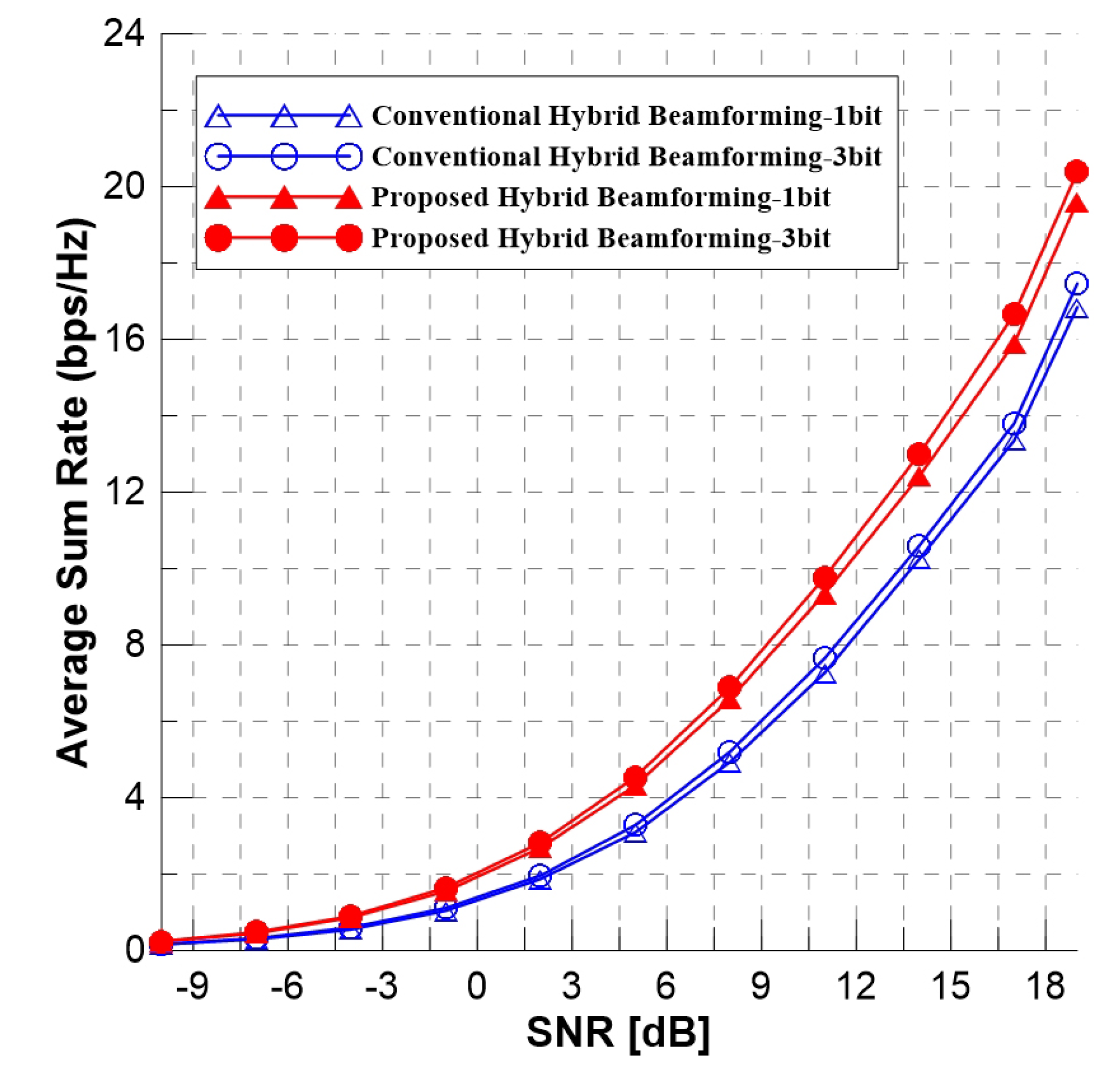
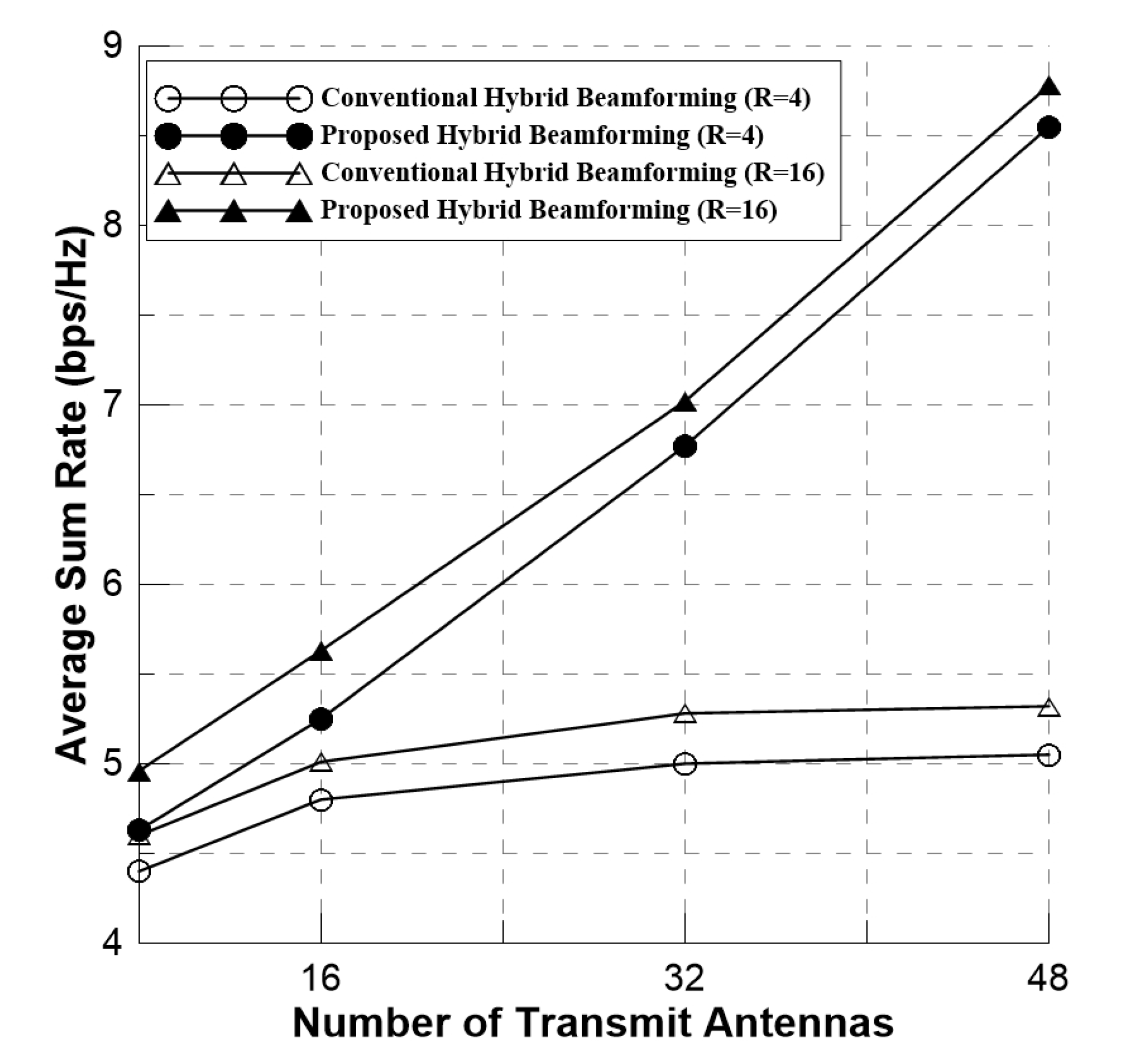
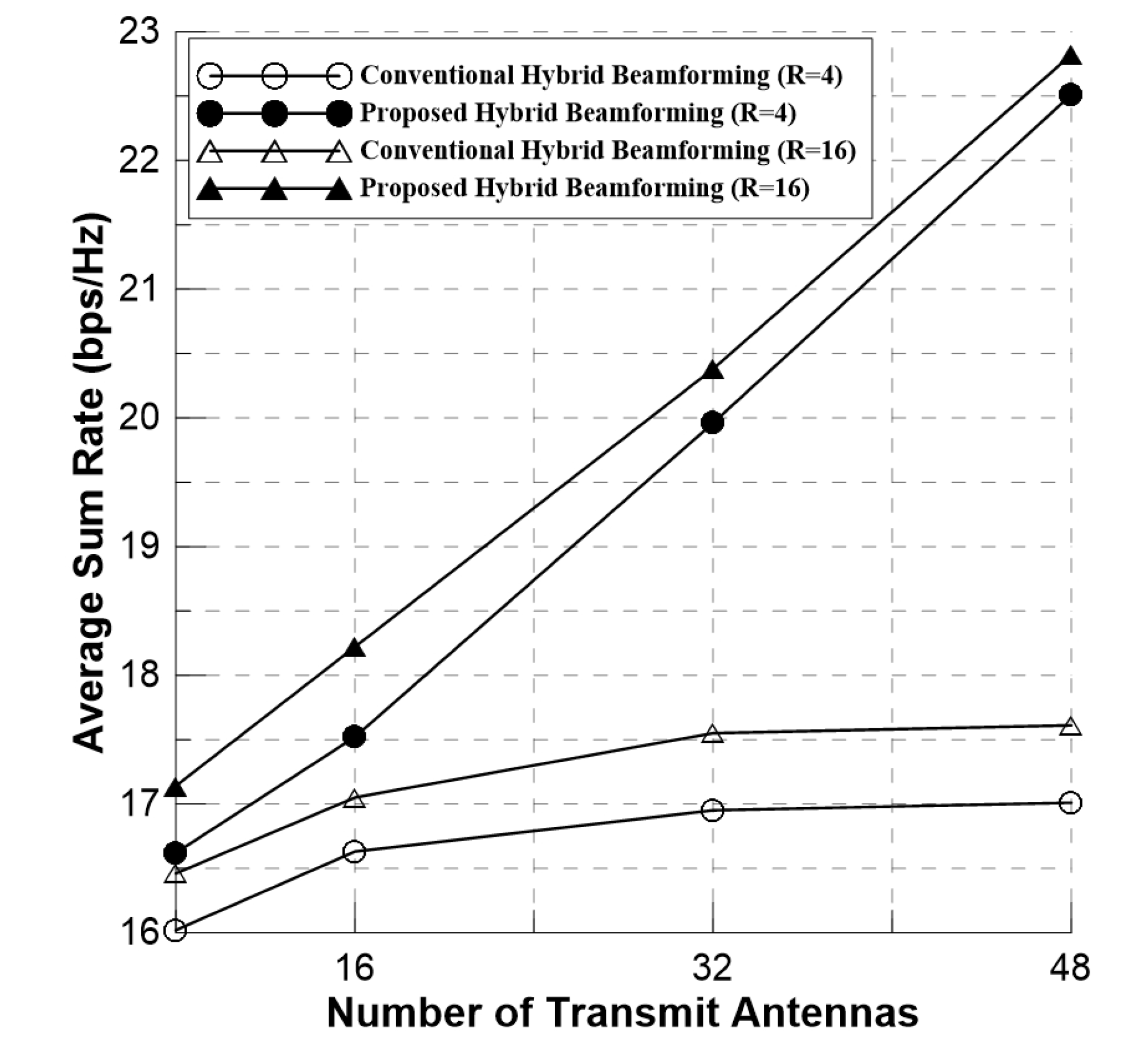
| Multi-Path Index | Elevation Angle | Azimuth Angle |
|---|---|---|
| 1 | ||
| 2 | ||
| 3 | ||
| Range of angle |
| Beam Pattern Index | |
|---|---|
| 1 | |
| 2 | |
| 3 | |
| 4 | |
| ⋮ | ⋮ |
| 9 |
| 1 bit | 2 bit | 3 bit | |
|---|---|---|---|
| Conventional Hybrid Beamforming | 1,120,000 | 4,480,000 | 10,080,000 |
| Proposed Hybrid Beamforming (Feedback channel is required) | 1,120,000 | 4,480,000 | 10,080,000 |
© 2020 by the authors. Licensee MDPI, Basel, Switzerland. This article is an open access article distributed under the terms and conditions of the Creative Commons Attribution (CC BY) license (http://creativecommons.org/licenses/by/4.0/).
Share and Cite
Shim, S.-J.; Lee, S.; Lee, W.-S.; Ro, J.-H.; Baik, J.-I.; Song, H.-K. Advanced Hybrid Beamforming Technique in MU-MIMO Systems. Appl. Sci. 2020, 10, 5961. https://doi.org/10.3390/app10175961
Shim S-J, Lee S, Lee W-S, Ro J-H, Baik J-I, Song H-K. Advanced Hybrid Beamforming Technique in MU-MIMO Systems. Applied Sciences. 2020; 10(17):5961. https://doi.org/10.3390/app10175961
Chicago/Turabian StyleShim, Seong-Joon, Seulgi Lee, Won-Seok Lee, Jae-Hyun Ro, Jung-In Baik, and Hyoung-Kyu Song. 2020. "Advanced Hybrid Beamforming Technique in MU-MIMO Systems" Applied Sciences 10, no. 17: 5961. https://doi.org/10.3390/app10175961





